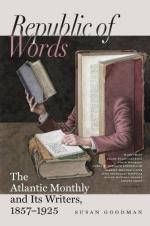In the interest, therefore, of education no less than health, it becomes imperative that machinery should be substituted for hand-labor in composition. At present, our printing-offices are by no means the sources whence to draw inspirations of order, fitness, and wholesome toil. On the contrary, they are frequently badly lighted and worse ventilated rooms, wherein workmen elbow each other at the closely set cases, and grow dyspeptic under the combined pressure of foul air and irritating and long-protracted labor. All this should be changed. With the composing-machine would come an atmosphere of order and cleanliness and activity, making work rapid and agreeable, and lessening the period of its duration. I know that working-men are suspicious of scientific devices. But surely the compositor need not fear that the iron-handed automaton will snatch the bread out of his mouth. To diminish the cost of any article produced—which is the almost immediate result of substituting machinery for hand-labor—is to expand the market for that article. The Sewing-Machine has not injured the sempstress. The Power-Press has not injured the pressman. The Type-Setting Machine will not injure the compositor. Skilled labor, which must always be combined with the inventor’s appliances for aiding it, so far from dreading harm in such association, may safely anticipate, in the far-reaching economy of science, ampler reward and better health, an increase of prosperity, and a longer and happier life in which to enjoy it.
Let me now briefly sketch the history of type-setting machinery. This must necessarily be done somewhat in the manner of Mr. Gradgrind. I am sorry thus to tax the reader’s patience; but facts, which enjoy quite a reputation for stubbornness, cannot easily be wrought into fancies. Color the map as you will, it is but a prosy picture after all.
Charles Babbage, of London, the inventor of the Calculating-Engine, first essayed the application of machinery to composition. His calculator was so contrived that it would record in type the results of its own computations. This was over forty years ago. At about the same time Professor Treadwell of Cambridge, Massachusetts, who was bred a practical mechanic, turned his attention to this improvement, and ascertained by experiment




